-
Notifications
You must be signed in to change notification settings - Fork 30
ScenarioTransmission
OpenMalaria simulations of malaria transmission require specification of:
-
The level and seasonality of exposure (measured by the Entomological Inoculation Rate, EIR) to malaria at the start of the simulation
-
The model for transmission from mosquitoes to humans and the dynamics of malaria parasite cycle within humans.
-
The model for malaria transmission from humans to mosquitoes
-
The entomological model. There are two different variants of the entomological model:
-
The "Non-vector" variant does not consider mosquito dynamics and hence uses fixed or periodically (seasonally) varying vectorial capacity. It is appropriate for modeling situations with only interventions such as chemotherapy or vaccines that only act on humans and is described in: Smith et al, 2006.. Specification of this variant is described below
-
The "Vector" variant comprises discrete-time population models that simulate how many mosquitoes belong in each of several categories at each time. The models assume that the infectious (sporozoite positive) mosquitoes act to distribute infections at random to the human population (with human exposure proportionate to availability). Entomological interventions modify the vectorial capacity and require the "vector" transmission model variant. The simulations that include non-periodic changes in the vectorial capacity use a seasonally forced version of the difference equation model for vector dynamics of Chitnis et al (2008)Journal of Biological Dynamics Vol. 2, No. 3, July 2008, 259–285, further described in Chitnis et al (2010) American Journal of Tropical Medicine and Hygiene Vol. 83, No. 2, 230--240.
The "Vector" transmission model is required for modeling interventions that have effects on mosquitoes, and hence change the vectorial capacity. The XML parameters for specifying this sub-model are described below and the parameterisation of mosquito lifecycles and behaviour here.
-
The default use of both the "non-Vector" and "Vector" model variants follows the original Ross-Macdonald model in assuming that intervention-induced reductions in adult mosquitoes do not affect the numbers of emerging females, (which depend on local carrying-capacity of the breeding sites). OpenMalaria also supports an extension of the "Vector" model variant that incorporates a full-life cycle model that can capture effects of adulticiding on emergence, described here.
All OpenMalaria simulations begin with an initialisation phase that attempts to create a steady state of both vector and human populations, with a periodicity of one year. With both the "non-Vector" and "Vector" model variants this initialisation will fail if a seasonal pattern of transmission is specified that is not compatible with endemic malaria (for instance if the input EIR is too low, or if transmission is extremely seasonal). Failure at the initialisation stage is more likely with the "Vector" model because there is no check of whether the specified patterns of seasonality in transmission are compatible with the specified survival rates of the mosquitoes.
The "non vector" model assumes a fixed seasonal vectorial capacity, and either forces inoculation rates (EIR) or makes EIR dependent on human infectiousness to vectors while forcing vectorial capacity. Initial exposure of humans to infectious mosquito bites is input and any intervention effects on transmission to the mosquito translate into proportionate effects on transmission back to the human. This model is valid when the only interventions are ones that do not affect the vectorial capacity (e.g. vaccines or chemotherapeutic interventions). When vector control interventions are applied, the "Vector" model must be used.
The nonVector element primarily consists of a list of daily EIR (Entomological Inoculation Rate) parameters (EIRDaily elements) specifying the annual EIR (thus 365 values are expected) (see example above). Assuming the first value is the EIR for January 1st, time 0 corresponds to the beginning of the year (since this is the only input affecting seasonality it can be rotated as desired).
Values in this list are averaged per timestep to calculate the EIR per timestep of the year for the pre-intervention equilibrium state. Where data for more than one year are provided, the data is assumed to wrap into the next year and all values for the same timestep of the year are averaged.
nonVector also has an eipDuration attribute: the extrinsic incubation period (sporozoite development time, in days), which determines the delay before changes in human infectiousness affect the EIR (in dynamic mode only),
and an annualEIR element, which is an optional number. If this is provided, the EIR description is scaled such that the total number of infectious bites per adult is this number.
An example of the entomology element, for the non-vector model variant is thus as follows:
<entomology mode="4" name="a name">
<nonVector eipDuration="10">
<EIRDaily origin="monthly">0.0738</EIRDaily>
<EIRDaily origin="monthly">0.0738</EIRDaily>
<EIRDaily origin="monthly">0.0738</EIRDaily>
<EIRDaily origin="monthly">0.0738</EIRDaily>
<EIRDaily origin="monthly">0.0738</EIRDaily>
<EIRDaily origin="monthly">0.0738</EIRDaily>
...
</nonVector>
</entomology>Attributes of the entomology element also include the name which is simply a text string giving a user-friendly name for the transmission Setting.
Note that prior to schema 24, the vector model used EIR in units of infectious bites per person per time-period, averaged across the population, while the non-vector model used units of infectious bites per adult per time-period. From schema version 24 both use units of infectious bites per adult per day/timestep/month/year. (The difference being that children receive fewer bites than adults.)
The changeEIR intervention can be used to override the default transmission settings with the non-vector transmission model (but not with the [vector] model). It is used to simulate the impact of an intervention package with known impact on EIR, either on public health outcomes, or on as a factor modifying the impacts of interventions that can be simulated with the non-vector transmission model. It can be used, for example, to switch to EIR settings recorded during a trial, while retaining the main transmission description for the warm-up and pre-trial periods of the simulation. This intervention updates the transmission model with an entirely new description. It is described like:
<interventions>
<changeEIR name="name of new transmission settings">
<timedDeployment eipDuration="10" time="0">
<EIRDaily origin="interpolate">0.00219</EIRDaily>
<EIRDaily origin="interpolate">0.00210</EIRDaily>
<EIRDaily origin="interpolate">0.00202</EIRDaily>
...
</timedDeployment>
</changeEIR>
...
</interventions>The new EIR is always matched to the whole intervention period, thus must contain enough entries to cover from the beginning of the intervention period to the end, even if not deployed at time 0 or replaced before the end of the simulation. Values are, however, only used from the time of deployment (with some values potentially going unused).
Any number of timedDeployment elements may be used, each of which specifies a time of deployment (in timesteps) and has the same type of content as the nonVector element used to describe the initial transmission.
Deploying a changeEIR intervention changes the transmission mode parameter to static (human infectiousness to mosquitoes has no further effect on EIR).
The vector model allows simulation of any number of different vectors, each of which can have different interactions with hosts, where hosts may be humans or one of a few specified non-human populations (e.g. sprayed & unsprayed animals).
The vector element of the XML is used to specify the parameters of the life-cycle of the mosquito vector.
This consists of a list of one anopheles sub-element for each vector taxon, followed by a list of zero or more nonHumanHosts sub-elements. Each anopheles element has sub-elements mosq, and a list of zero or more nonHumanHosts. It also includes specification of the level of transmission attributable to that vector at the start of the simulation. Since the seasonal patterns of abundance of different Anopheles species are different, a separate seasonal pattern of transmission for each species must be specified using either EIR or monthlyEIR sub-elements within the anopheles sub-elements.
EIR can be specified either via 5 Fourier coefficients and a rotation factor (EIR element) or via 12 monthly values plus an annual level (monthlyEIR element). Exactly one of these elements must appear.
The models also require as input, data on the overall average transmission level in the absence of interventions (measured by the entomological inoculation rate, EIR).
Data on seasonality of malaria transmission for driving models might be available in the form of seasonality in any of a number of malariological indices (see Table below). The models, however, expect the seasonality in the EIR as the input. If the data are available in the form of a different measure of seasonality, they need to be transformed before being used to drive the models. The easiest approximation is to introduce a fixed lag period, depending on which measure is used. While this is a considerable simplification, because it assumes proportionality between different measures, this may be reasonable, especially if the data relate to mosquito densities or emergence rates.
The table contains suggestions for what might be the approximate lag periods between different measures of seasonality. A positive value (Lx) for the lag for measure x implies that the EIR seasonality reflects the value of x, Lx days previously. This table provides only a very approximate guide with values rounded to multiples of 5 days. The actual average lag periods in the simulations are model dependent and will vary somewhat from these. The lag periods in the field also vary and, in the case of quantities measured in the vector population, are dependent on the environmental temperature.
Table: Approximate lag periods between different seasonality measures
| Transmission measure | Lag period (Lx) (days) |
|---|---|
| Rainfall | +30 |
| Emergence rate of vector | +20 |
| Density of host-seeking vectors | +10 |
| Entomological inoculation rate | 0 |
| Incidence of infection | -5 |
| Incidence of patent infection | -10 |
| Incidence of clinical malaria | -15 |
| Incidence of severe malaria | -20 |
EIR can be specified either via 5 Fourier coefficients and a rotation factor (EIR element) or via 12 monthly values plus an annual level (monthlyEIR element). Exactly one of these elements must appear.
This is the older method (the only available method before schema version 22).
The EIR element describes the Entomological Infection Rate for this mosquito species, which is used as a target when fitting the emergence rate of adult mosquitoes. The EIR is given via a Fourier series and a rotation offset; more accurately, the exposed EIR, in units of bites per day, is:

<a href='Hidden comment: Above image rendered as latex from: \Xi_t = \exp \left( a_0 + \sum_{n=1}^2 \left[ a_n \cos \left(n (w t - \theta) \right) + b_n \sin \left(n (w t - \theta) \right) \right] \right) (Use, for example, [http://sciencesoft.at/latex/?lang=en] with the AMS maths formula template.)
MathML version (not so nice and less compatible): <wiki:gadget url="http://mathml-gadget.googlecode.com/svn/trunk/mathml-gadget.xml" border="0" up_content="eir_t = exp ( a_0 + sum_(n=1)^2 { a_n cos(n (w t - theta)) + b_n sin(n (w t - theta)) } )"/>
(Formula uses MathML. For IE, a [http://www.dessci.com/en/products/mathplayer/ plugin] is needed.)'>
Here, Ξt is the number of innoculations per person per day, where t is the day of year (from 0 to 364), w = 2π / 365, θ is the EIRRotateAngle attribute and a0 to a2, b1 and b2 are the corresponding attributes of the EIR element.
If we introduce the function f(t) dependent on an and bn for n≥1, we can reformulate Ξt as

and thus show that the annual EIR is scaled by  :
:
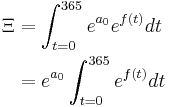
This is configured using a section in the XML, per species, similar to the following:
<seasonality annualEIR="178.60558666831946" input="EIR">
<fourierSeries EIRRotateAngle="0">
<coeffic a="-0.692164" b="0.002098"/>
<coeffic a="0.401189" b="-0.375356"/>
</fourierSeries>
</seasonality>
As of schema version 22 this method of entering EIR was added to simplify entry of field data. Fourier coefficients are still used within the code (for smoothing), but are calculated internally.
You can use this Fourier Calculator to convert monthly values to Fourier coefficients.
The monthlyEIR element requires one attribute: annualEIR, specifying the total annual EIR as infectious bites per person per year. It should have a sequence of 12 child elements, named item, specifying the relative in terms of infectious bites per person per month (which might be approximated by densities of mosquito densities, with an appropriate lag), in the months of January through December. The overall EIR is scaled to the annualEIR value indicated at the top of the element. An (unrealistic) example:
<seasonality annualEIR="20" input="EIR">
<monthlyValues smoothing="fourier">
<value>10</value>
<value>1</value>
<value>1</value>
<value>1</value>
<value>1</value>
<value>1</value>
<value>1</value>
<value>1</value>
<value>1</value>
<value>1</value>
<value>1</value>
<value>1</value>
</monthlyValues>
</seasonality>
Each has a name, which serves as an identifier for the Anopheles species or non-human-host category (for example, to match per-species vector intervention parameters specified elsewhere with the correct species).
Located within the anopheles sub-element, the initial conditions to start the simulation (actual values do not impact the results) include the propInfected and propInfectious per-species mosquito parameters.
| name | type | unit | description |
|---|---|---|---|
| propInfected | int | proportion | Proportion of vectors infected (oocysts identified in midgut or would develop oocysts if kept alive - usually called the delayed oocyst rate in entomological literature) in the month the simulation starts |
| propInfectious | int | proportion | Proportion of vectors infectious (sporozoites identified in salivary glands) in the month the simulation starts |
Complete specification of the anopheles sub-element also requires parameterisation of mosquito lifecycles and behaviour.
Enter your daily or monthly values in the calculator here: https://swisstph.github.io/openmalaria/fourier You will receive an xml snippet which you can copy-paste in your scenario file as follows:
<seasonality annualEIR="XXX" input="EIR">
...
</seasonality>This section attempts to describe the range of parameters where OpenMalaria is able to accurately reproduce the input EIR profile.
The following plots show the normalized l2-norm between the simulated EIR and the input EIR. A value above 1 means that the corresponding simulated EIR was too far from the input and that OpenMalaria was not able to obtain a good fit. Typically, this will happen if the input EIR is too small or if the seasonality profile is too steep.
The following experiments were done using version 42, and two mosquito species were used.
Varying EIR and seasonality profile (first Fourier coefficient only). The following snippet was used:
<seasonality annualEIR="0.083" input="EIR">
<fourierSeries EIRRotateAngle="0">
<coeffic a="@a1@" b="0"/>
<coeffic a="0" b="0"/>
</fourierSeries>
</seasonality>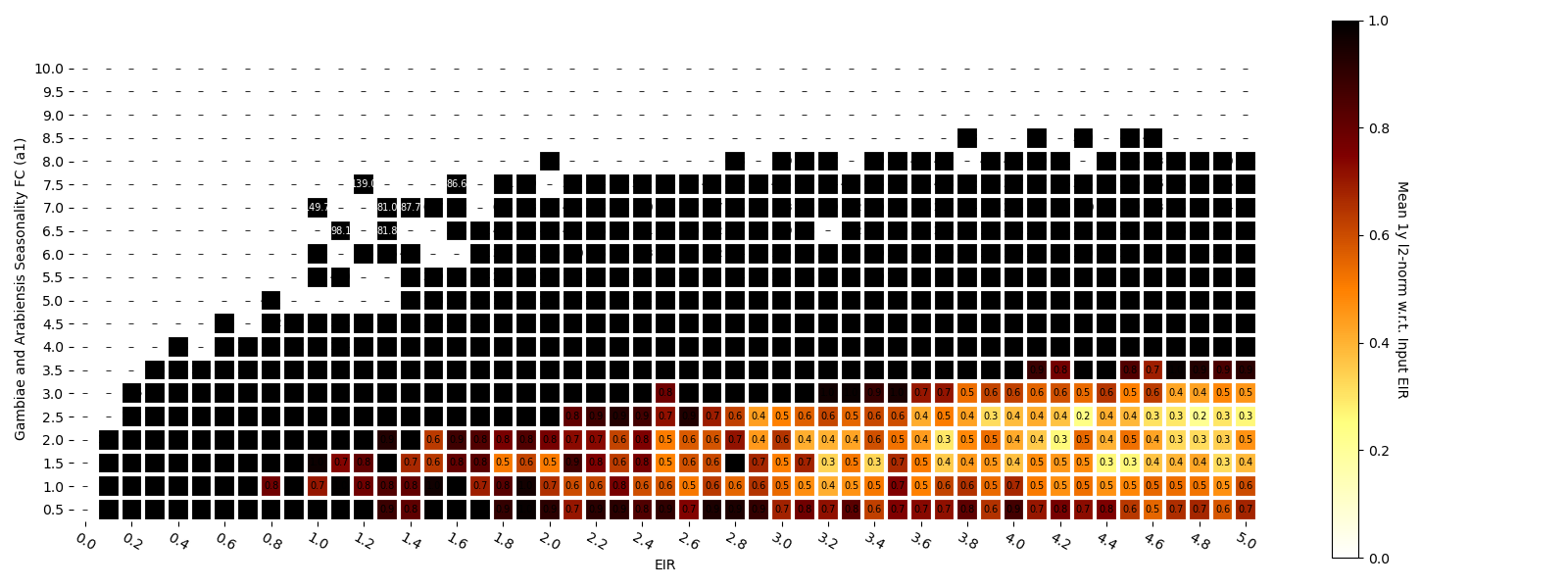
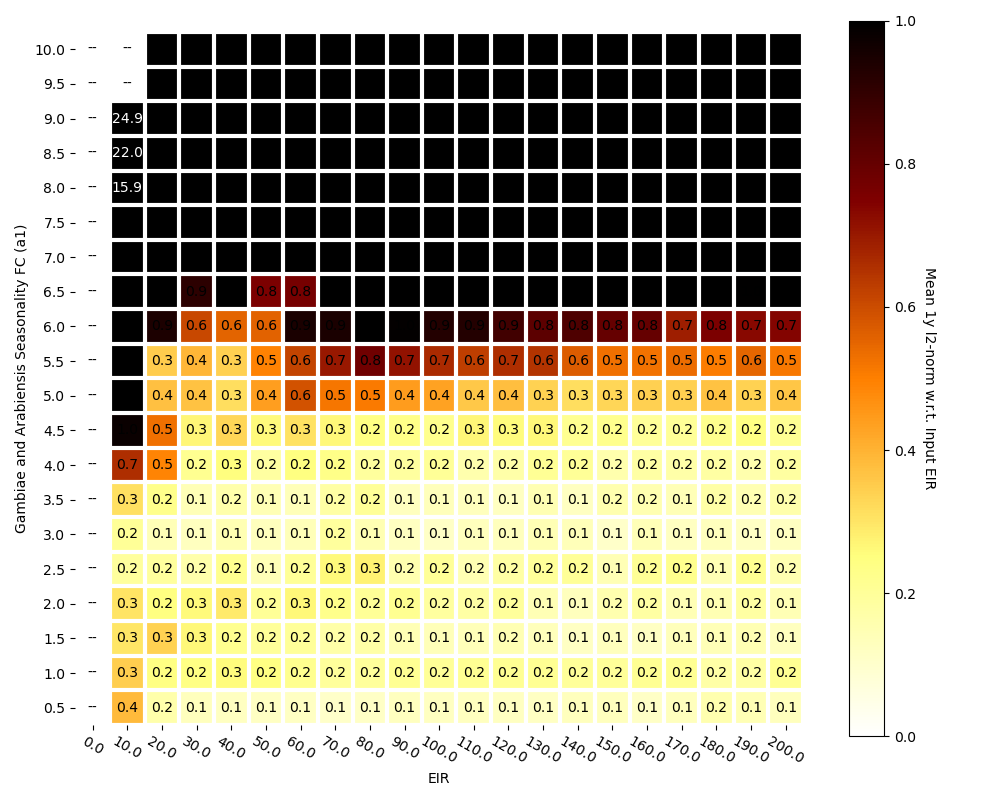
Varying seasonality profile (first Fourier coefficient only).
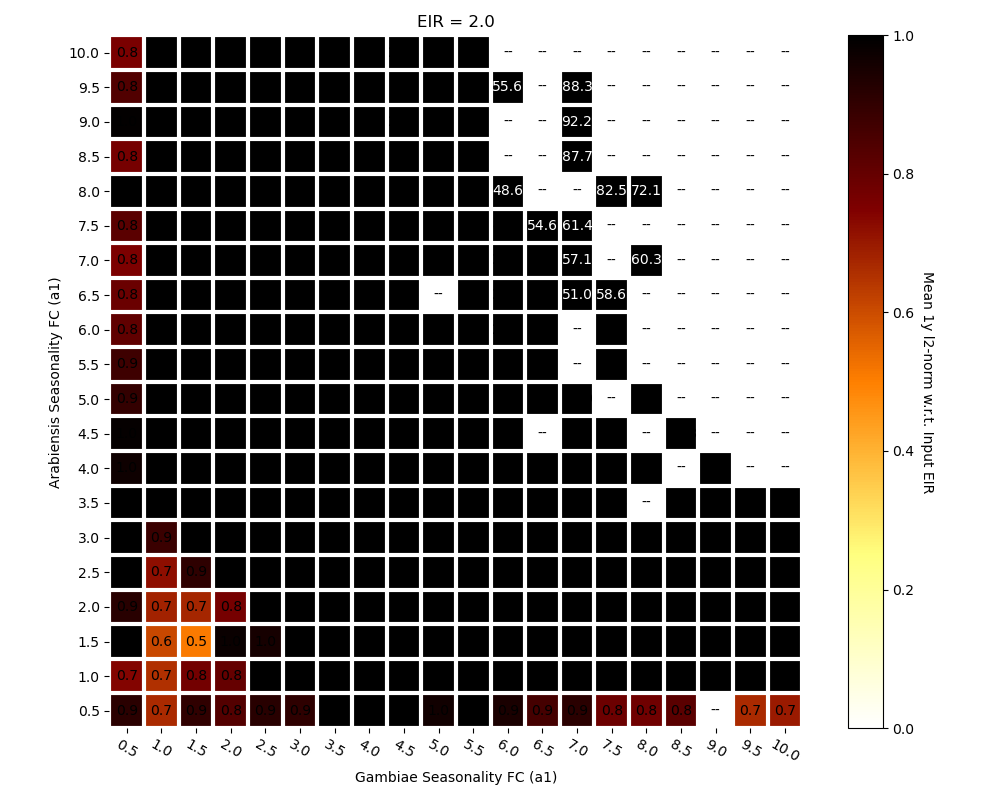

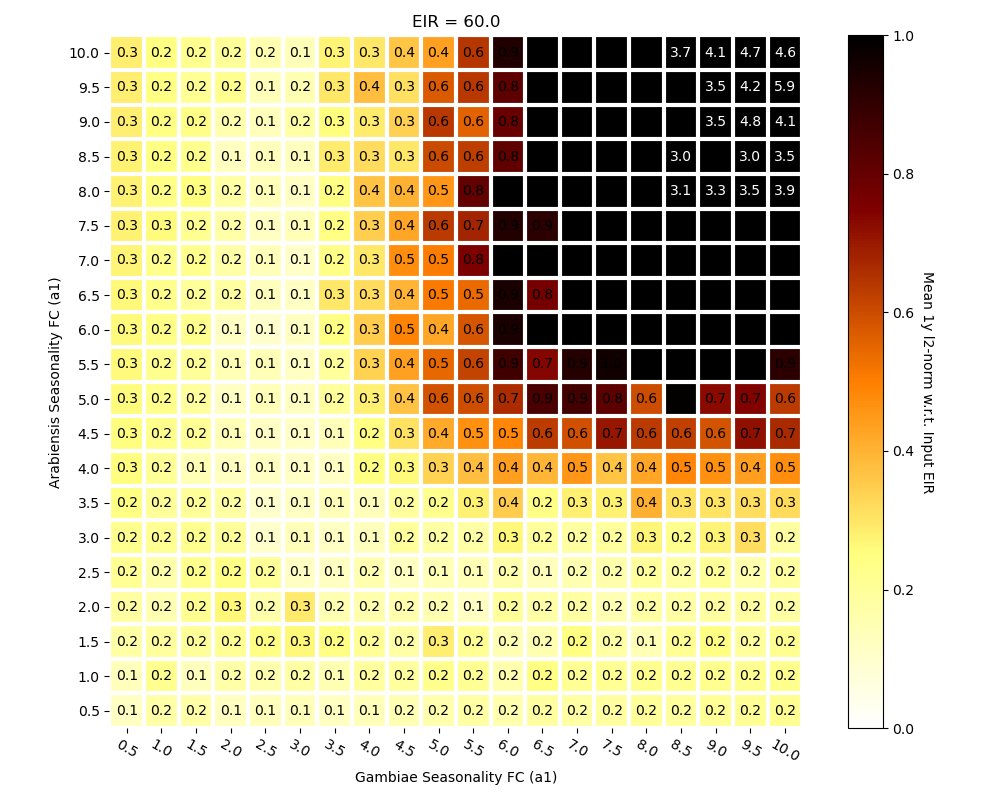
| Download openmalaria | Installation instructions | XML Schema Documentation |
| XML Schema Version | Program version | master |
develop |
|---|---|---|---|
| 43 | schema-43.0 |
|
|
- User Guide
- Compilation Guide
- Developer Guide
- Schema Update Guide
- Scenario Design Guide
- Monitoring Guide
- Changelog
- Schema Documentation
- Human demography
- Levels of transmission
- Parasite dynamics within humans
- P vivax dynamics
- Vector bionomics and transmission to humans
- Mosquito population dynamics
- Clinical (illness) models
- Time in the models